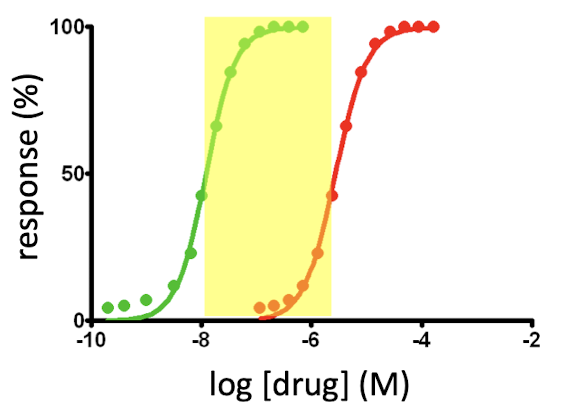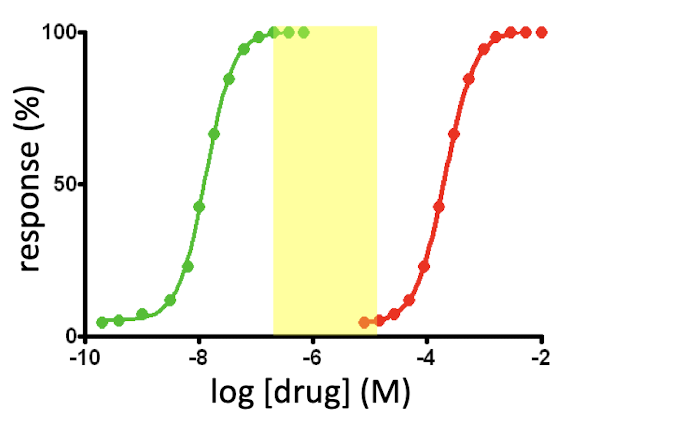2. Basic Principles of Toxicology
1/45
There's no tags or description
Looks like no tags are added yet.
Name | Mastery | Learn | Test | Matching | Spaced |
|---|
No study sessions yet.
46 Terms
Who was the grandfather of toxicology?
Paracelsus
What is basic principle #1?
everything is toxic at the right dose
What does NOAEL stand for?
no observed adverse effect level
used a lot for drug development and the maximum dose that can be safely used
NOAEL
What does LD50 or LC50 stand for?
lethal dose/concentration that kills 50% of a test population
What does MTD stand for?
minimum toxic dose
lowest level where you will start to see toxic signs
MTD
What does MLD/MLC stand for?
minimum lethal dose/concentration
Which value is likely of most clinical use?
minimum toxic dose (MTD)
True or false: There are species specific values for toxicity. Cats are not small dogs. They have different metabolic profiles. Therefore, toxic things to cats might not be toxic to dogs and vice versa.
true
True or false: Experimental conditions to determine toxicity measures can vary greatly from real-world cases.
true
What is basic principle #2?
exposure does not equal intoxication
How is a toxic effect achieved?
toxin must be absorbed and reach its site of action at a high enough concentration and for a sufficient period of time
What does treatment often involve? Why?
decontamination; get toxin away from animal before it can get absorbed
When it comes to basic toxicokinetics, what is there a big difference between?
species
What are the basic events when it comes to basic toxicokinetics?
A
D
M
E
absorption
distribution
metabolism
excretion
What are the different routes of absorption?
O
D
I
I
orally/ingestion
dermal exposure
injection
inhalation
Can we minimize absorption?
yes through decontamination
What are factors when it comes to distribution?
F
P
P
M
fat solubility vs. water solubility
protein binding
pH of tissues and compartments
many other factors
Can we take advantage of these properties of distribution to limit exposure of the target organ?
depending on the characteristics, can manipulate and trap a drug in a compartment and interfere with the absorption
What happens during metabolism? Why is this important?
biotransformation; metabolites are more readily excreted
What occurs during biotransformation? Where does this commonly occur?
often converted to a more water-soluble product; often in the liver, but also in many other organs
True or false: Big species differences can exist for various metabolic pathways.
true
True or false: Sometimes metabolites are less toxic and sometimes metabolites are more toxic.
true
What are the primary routes of excretion?
U
B
M
urinary
biliary/fecal
milk, sweat, saliva
What is basic principle #3?
the typical dose-response curve has important exceptions/variations
What are some exceptions to the typical dose-response curve?
E
T
essential nutrients
therapeutic medications
What vitamins are less likely to cause toxicity? Why?
water soluble vitamins; excreted in urine
ratio of the dose of the drug that produces an unwanted (toxic) effect to that producing a wanted (therapeutic) effect
therapeutic index
What is the formula for the therapeutic index?
LD50 / ED50
What is the safety ratio?
LD1 / ED99
Drugs with what type of therapeutic index should be avoided if possible? Why?
those with a small therapeutic index; want high margins (if 2 tablets were given instead of 1, there is likely chance to cause toxic effects

What type of therapeutic index is this?
small

What type of therapeutic index is this?
large
What is basic principle #4?
many factors influence toxicity
What are some factors that influence toxicity?
C
R
F
C
E
characteristics of the animal/animals exposed
route of exposure
frequency of exposure
characteristics of the toxicant
environmental conditions
What are characteristics of the animal that can influence toxicity? Which is the most important?
S
G
A
S
C
C
N
species
genetic differences
age
sex, reproductive status
concurrent disease
concurrent exposure to other drugs or chemicals
nutritional status
species
What are characteristics of the toxicant that can influence toxicity?
F
V
I
D
I
S
formulation, vehicle
valence state of metals
ionization
decomposition
impurities
strain/subspecies
What are the different types of frequencies of exposure? Why are these important?
O
R
C
one time exposure
repeated exposures
cumulative effects
some toxins may require accumulation from chronic/repeated exposures
What environmental conditions can influence toxicity?
D
T
G
T
P
W
drought
time of the year
growth stage
temperature
photo period
winds
True or false: Asking the question “is this toxic” is the wrong question. Instead, you should ask at what dosage, in what species, and under what conditions.
true
The ________ makes the toxin. Everything is toxic at a ________ enough dose.
dose; high
When are dose calculation used in toxicology?
used in cases involving a known exposure to a specific toxicant
Why is it important to calculate a dose of exposure?
to determine if the dose is high enough to pose a risk of intoxication or death
Why should you not just treat any exposure?
R
A
risks and expense of treatment may outweigh the risk of intoxication
aggressiveness of treatment will be determined by the severity of intoxication
KNOW HOW TO DO CALCULATIONS!!!!!